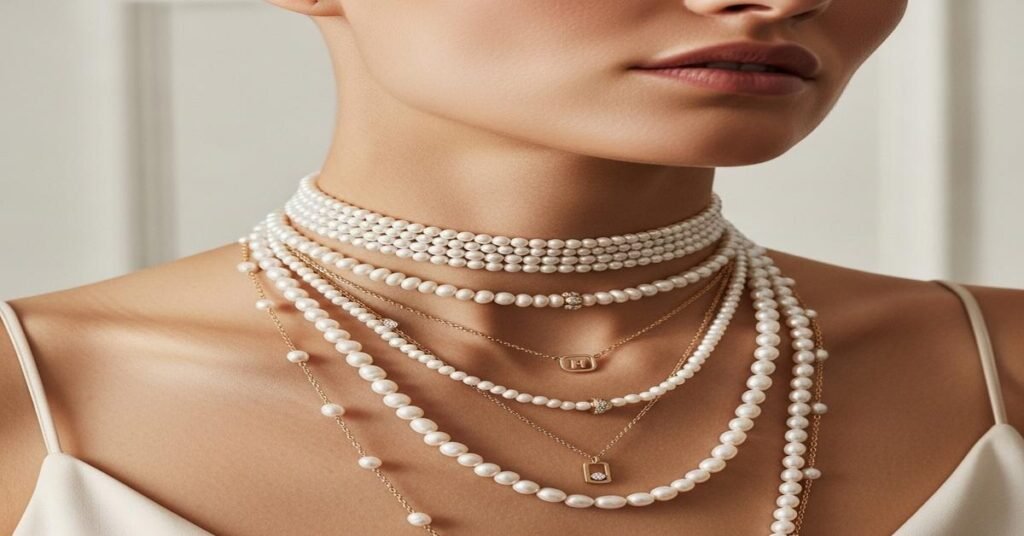Pearls and chokers are reappearing on runways and in street style for 2026, but that’s only the start. Jewelry next year pushes contrast: classic materials in modern shapes, small sustainable upgrades, and bold pieces meant to be mixed. Below are the five biggest jewelry trends you’ll see everywhere next year, why they’re happening, and how to buy and care for them so your pieces last.
Pearls, updated
Pearls are no longer just a single strand of Akoyas. Expect baroque and freshwater pearls in irregular shapes, pearl-only chokers, and mixed-metal pearl chains. Why this matters: pearls bring a tactile, vintage feel, but designers update them by changing scale and setting.
- Types and sizes: Freshwater pearls are common and affordable at 6–9 mm. Akoya pearls sit at 7–8 mm with a classic round look. South Sea pearls are 9–14 mm and read more luxurious.
- Modern treatments: Baroque pearls (irregular) are often drilled for link settings. Expect pearls set alongside 14k or 18k gold beads, or threaded into mixed-metal chains.
- Practical tip: Pearls are porous. Avoid perfume and lotions; put them on last. Re-string pearl necklaces every 6–12 months if you wear them often.
Chokers, but smarter
Chokers return in many forms: slim metal bands, soft leather with gold accents, and tight link chains layered under longer necklaces. They’re back because short necklines and layered looks remain strong, and chokers anchor those layered styles.
- Lengths and widths: Typical choker lengths are 14–16 inches. Metal widths range from delicate 1–2 mm bands to wider 6–8 mm cuffs.
- Materials: Expect 14k gold-filled or vermeil (925 sterling silver base with ≥2.5 microns gold) for affordable longevity, and solid 14k/18k gold for investment pieces. Leather and woven textiles appear in casual collections.
- How to wear: Use a choker as an anchor and add a 16–20 inch necklace or a 24–30 inch pendant for contrast. If you wear a metal choker daily, check clasps and edges—thin plated chokers wear faster.
Chunky chains and sculpted links
Oversized links—curb, paperclip, and sculpted chain forms—remain dominant. They pair with pearls and silencers as statement pieces. The trend persists because chains read bold without the cost of large gemstones.
- Dimensions: Chain link diameters range from 3 mm (delicate paperclip) to 10 mm+ (statement curb). Heavier chains will weigh 20–60 grams depending on length and metal.
- Metal choices: 14k gold is common for daily wear (58.3% gold, harder than 18k). 18k gives a richer color but is softer. For budget-friendly options, gold vermeil or gold-filled pieces offer longevity without the price of solid gold.
- Buying note: If you want daily wear, choose solid 14k gold or heavy vermeil. Thin gold-plated chains will show base metal in months.
Colorful gems and mixed stones
2026 favors colored stones set in elegant, wearable ways. Think 1–3 ct center sapphires, emeralds, or tourmalines in bezel settings and micro-pavé accents. Color gives a personal touch and moves jewelry away from solely diamond-centric looks.
- Popular cuts and sizes: Oval and cushion cuts are common at 1–3 ct for rings and pendants. Accent diamonds in micro-pavé are tiny—0.005–0.02 ct each—creating sparkle without heavy weight.
- Settings: Bezels and low-profile prongs protect stones for everyday wear. Bezel-set 2 ct sapphires sit lower and resist knocks better than tall prong settings.
- Practical advice: For colored stones, check origin and clarity. Some gems (e.g., emerald) often have oils or fractures; a protective bezel is useful. For frequent wear, pick harder stones—sapphires and spinels over softer gems like opal.
Sustainable and lab-grown options go mainstream
Sustainability is not a niche anymore. Recycled metals, responsibly mined stones, and lab-grown diamonds are central. Why: buyers want traceability and better price-to-quality ratios. Designers respond with visible sustainability cues, not just labels.
- Metals: Recycled 14k or 18k gold has the same alloy composition (14k = 58.3% gold; 18k = 75% gold) but a smaller environmental footprint. Vermeil made on recycled silver reduces cost further.
- Diamonds: Lab-grown diamonds offer the same chemical structure as mined stones at a lower price. A 1 ct lab-grown diamond can cost 30–50% less than mined equivalents of similar clarity and color.
- How to evaluate: Ask for documentation—recycled-metal certificates or origin reports for colored gems. For diamonds, compare GIA-equivalent lab reports for cut, color, and clarity.
How to choose and keep pieces you’ll actually wear
Trends are useful, but buy with purpose. Choose one investment piece and two trend pieces. Here’s how to match pieces to your lifestyle and keep them in good shape.
- Choose metals by wear: If you wear jewelry daily, favor solid 14k gold or heavy vermeil. Save delicate plated pieces for occasional use.
- Balance scale and comfort: For rings, 1.5–3 mm bands stack well. For necklaces, pair a 14–16 inch choker with a 20–24 inch pendant for layered balance.
- Care basics: Pearls: wipe with a soft cloth, avoid chemicals, re-string as needed. Gold: clean with mild soap and a soft brush. Avoid ultrasonic cleaners for softer gems and pearls.
- Repair and maintenance: Inspect clasps and prongs every 6–12 months. Tighten loose settings quickly to avoid stone loss.
In short: pearls and chokers will be highly visible in 2026, but they arrive alongside chunky chains, colored stones, and a stronger focus on sustainability. Buy one timeless piece in solid metal, add a few affordable trend items in vermeil or lab-grown stones, and care for them simply to keep the look fresh year after year.
I am G S Sachin, a gemologist with a Diploma in Polished Diamond Grading from KGK Academy, Jaipur. I love writing about jewelry, gems, and diamonds, and I share simple, honest reviews and easy buying tips on JewellersReviews.com to help you choose pieces you’ll love with confidence.

